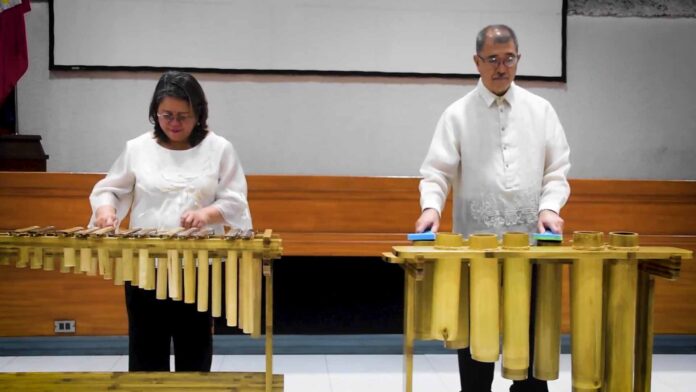In a very rare occasion, the scientific community has put together a collection of artists and performers through a virtual concert to showcase the country’s masterly crafted bamboo musical instruments in an effort to revitalize this modest but resilient industry through science and technology.
The virtual concert dubbed as Musika ng Kawayan, Yaman ng Bayan, organized by the Department of Science and Technology-Forest Products Research and Development Institute (DOST-FPRDI), has lined up various performances from individuals and groups that have sustained its existence amidst the pop culture that have alternatively replaced our cultural traditions with streamed music and movie binges.
According to DOST-FPRDI Director Romulo T. Aggangan, “the concert was a celebration of science, the creative arts, and Philippine culture.”
To turn things around, DOST-FPRDI has stepped in to help the bamboo musical instrument makers to further enhance their craft by introducing the latest techniques to complement their artistry. Earlier, DOST-FPRDI has rolled-out its Bamboo Musical Instrument (BMI) Innovation Research and Development program to address the various concerns around the industry. Among these are the quality of the bamboo instruments, design and aesthetics, process standardization, and raw materials sourcing.
On the other hand, the virtual concert hopes to reintroduce the beauty of the indigenous bamboo music and instruments to gain more support from the public as redesigned and improved bamboo musical instruments are coming in the years ahead.
Virtual concert
One of the highlights of the virtual concert was the performance of DOST’s top officials. Performing the traditional music tinikling, DOST Secretary Fortunato T. de la Peña and DOST Undersecretary for Research and Development Rowena Cristina L. Guevara played the kawagong, a term coined by Sec. de la Peña describing the gong sounding tubular kawayan (bamboo) poles, while Usec. Guevara played the bamboo marimba designed and developed by DOST-FPRDI.
The performance showcased the first two bamboo instruments that went further improvements under the innovation DOST-FPRDI R&D program.
The concert also featured a very interesting group from Dulag, Leyte’s Karatong Festival.
Karatong is the Waray (a native of and language in Leyte) word for bamboo. In the olden times, way before the Spaniards came to the Philippines, the people in Dulag used bamboos to warn the town from enemies who wanted to invade their lands.
The street dance festival featured an all-bamboo musical ensemble from drums to shakers. Some of the instruments were improvised to add the distinct sound that is purely Karatong Festival.
Orlando L. Cagara, vice chairman of the Karatong Festival, explained that previously their festival lost its original flavor as loud percussion music obfuscated its unique earthy sound that is distinct from other regional festivals. “The trumpets, the bugle, the steel xylophone, they are really loud, this is not karatong,” added Cagara.
This prompted the local organizers to return to the roots of the festival and actively encourage participants to explore the possibilities of developing new sounds out of bamboo materials. Consequently, one of the winners in last year’s celebration was a group from Labiran. They used karatong or a bamboo slit drum, katatoktok (lyre), hagughob (open tube drum), pagakpak (clappers), and bamboo marimba and play their rendition of the Dulag Festival song.
Perhaps the most popular BMI in the country is the Bamboo Organ of Las Piñas. Played by Prof. Armando Salarza, the nearly two century old bamboo organ has endured the test of times as it remains to be playable.
The bamboo organ also became the centerpiece of the International Bamboo Organ Festival held every year in the country.
The Bamboo Organ, declared in 2003 as the National Cultural Treasure, was created by Father Diego Cera in the 19th century. According to Celwyn Tagle of the Las Piñas Bamboo Organ Foundation, the bamboo pipes from the bamboo organ are harder to play than the conventional metal pipes as its upper lip and languid are both rigid and curved unlike metal pipes that have consistent upper and lower lips that make the air flow easier. Currently, the Bamboo Organ retains 70-80% of its original parts as curators believe is attributed to the Filipino intrinsic knowledge in bamboo preservation.
We also saw other performers like Professor Beni Sokkong, a Kalingan artist and BMI maker, performing a native Kalingan music Annowoy using Tongali, a bamboo nose flute. He also performed tupayya, a traditional instrumental solo using the polychordial zither called kolitong that emulates the musical patterns from gangsa flat brass gongs.
The famous Pangkat Kawayan also performed their version of the song popularized by Ruben Tagalog, Panaligan Mo Sinta using the bamboo instruments angklong, tipangklong, and bumbong while the Philippine Normal University Himig Kawayan played Pobreng Alindahaw.
As the orgranizer of the virtual concert, DOST- FPRDI Himig Kawayan performed a Filipino folksong medley followed by Cebu’s talented singer-composer Joseph Gara showcasing the Huni Ukelele. Topping the concert was a performance from Dipolog Community Rondalla with their rendition of the Peruvian Waltz and Joey Ayala’s Walang Hanggang Paalam and Pamilyang Magsasaka.

Science in creative arts
With the need to strengthen the bamboo industry and at the same time promote the Filipino culture, DOST-FPRDI laid the initial steps to develop the industry through the Bamboo Musical Instrument Innovation Research and Development Program.
The program will support the growth of the local BMI makers in the country that has been underdeveloped for several decades but is seen to provide livelihood as it has steady demands from local and international markets.
However, certain challenges need to be addressed by the industry and the government as gaps in the production impedes its growth. Among them are the poorly made instruments that are susceptible to insects and fungi attacks that not only mar its appearances but also decreases the sound quality of the bamboo instruments therefore resulting to instability in sound quality.
In order to induce life into the industry, DOST-FPRDI used the latest techniques in the drying process, design, and tuning among others to develop the production standards on certain bamboo instruments. For example, DOST-FPRDI used the engineered bamboo for the frame in making the bamboo Marimba used by the DOST officials in their performance.
Engineered bamboo is produced by binding together fibers, particles, strips or slats of bamboo with the right adhesive. Used worldwide to make attractive panels, floors, furniture and handicrafts, it is often stronger and less prone to warping than equivalent solid woods.
The marimba bars were subjected to thermo modification to enhance the dimensional stability and durability by undergoing heat process to remove moisture that affects its durability and sound quality.

BMI R&D Program
The Bamboo Musical Instruments (BMI) Innovation R&D Program was spearheaded by DOST-FPRDI in 2019 with the goal of improving the quality of locally-made BMIs.
“The DOST-FPRDI program aims to provide science-backed solutions to BMI problems on sound and structural qualities, playability, tuning and durability,” program leader Aralyn L. Quintos emphasized.
Specifically, the program aims to develop R&D technologies that will not only improve the life and quality of bamboo but also prevent it from affecting the musical instrument’s sound quality. Aside from this, the program also targets to standardize the production of selected BMIs and to potentially build a BMI processing facility.
“As an off-shoot, we hope to raise public awareness and appreciation for the cultural importance of these musical instruments,” Quintos added.
Under the program, DOST-FPRDI hopes to enable producers of BMI to collaborate on new designs to adopt to the changing times. It will also put up a bamboo musical instrument museum to help in educating the public to increase their knowledge and appreciation of the traditional bamboo musical instruments.
With these developments in the BMI industry, DOST Usec. Rowena Cristina L. Guevara is hopeful that through the DOST initiatives and with the support of its partners, “we have good reason to look forward to an invigorated BMI sector in the future.”






